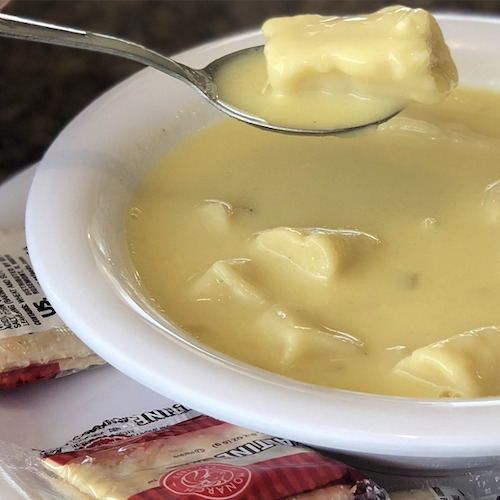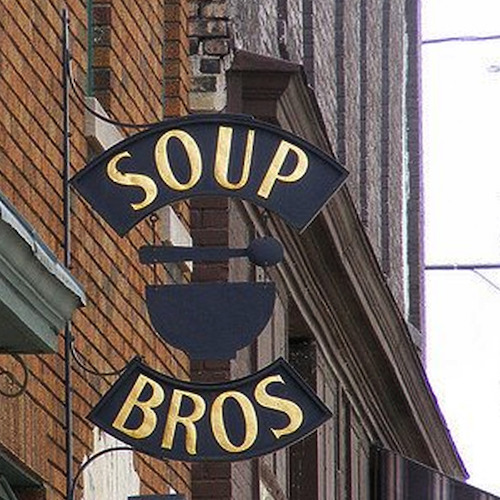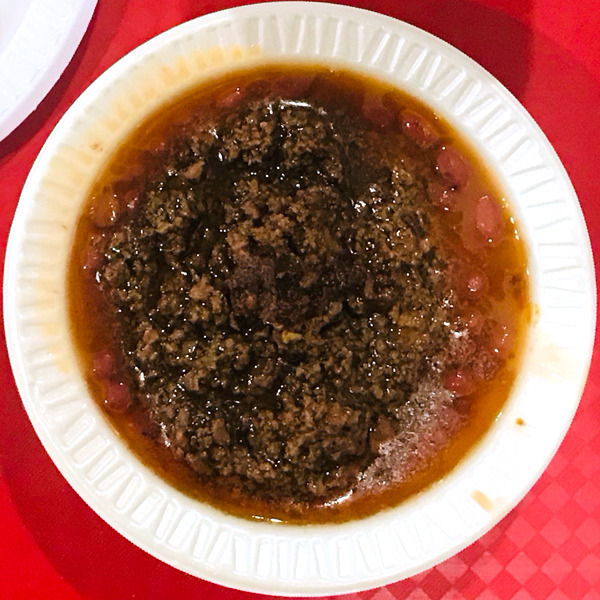Mock turtle soup is getting harder to find in Cincinnati. But you can still order a side with the famous fried chicken at Ron’s Roost in Bridgetown, pair it with a ground burger at Quatman Café in Norwood, or spoon it up alongside the authentic German dishes at Mecklenburg Gardens in Corryville. And you can still find canned mock turtle, made by Worthmore, in pantries all over the Queen City.
Cincinnati mock turtle soup is a sweet-and-sour stew of lean beef, hard-boiled eggs, ketchup, lemon, apple cider vinegar or lager beer, and spices. It bears a resemblance to Cincinnati’s famous chili: It has a similar texture, and we often serve it with the same crunchy oyster crackers that you get with a three-way at Skyline or Gold Star.
We didn’t invent mock turtle. It originated in England in the mid-1700s. The soup, which substituted calf heads, brains, tails, and trotters for expensive turtle, became so popular over the years that a character called the Mock Turtle—a melancholy animal with a turtle shell and calf parts—appeared in Lewis Carroll’s 1865 Alice in Wonderland. It spread beyond England. In 1714, the Hanoverian King George I had become king of England, uniting the nations, and so mock turtle crossed the channel to Hanover’s Oldenburg and Ammerland. Nearly half of Cincinnati’s Germanic immigrants came from that part of Germany. They brought their versions of mock turtle to the New World in the mid-1800s.
The soup, which substituted calf heads, brains, tails, and trotters for expensive turtle, became so popular over the years that a character called the Mock Turtle—a melancholy animal with a turtle shell and calf parts—appeared in Lewis Carroll’s 1865 Alice in Wonderland.
Mock turtle’s inspiration, real turtle soup, was also a hit in nineteenth-century Cincinnati. Advertisements in nineteenth-century German-language newspapers show that it came free with a beer at some bars in the Queen City. Turtle soup was Cincinnatian William Howard Taft’s favorite food and a staple in his White House.
Over time, for a variety of reasons, including overhunting, the destruction of turtle habitat, and the government protections that followed, turtle meat became harder to find. Mock turtle became more important than ever. Turtle connoisseurs say that our native snapping turtle contains seven distinct kinds of meat, reminiscent of pork, chicken, beef, shrimp, veal, goat, and fish. American mock turtle soup evolved to evoke the snapper, which had long filled in for sea turtle in our pots, incorporating beef, pork, and veal, and textured off-cuts such as tripe, tendon, and sweetbread.
For years, Campbell’s sold an American-style mock turtle soup, touting a “tempting, distinctive taste,” but the company discontinued it before 1960. Post-World War II, the soup’s popularity waned, but it held on in Cincinnati.
The city’s canned go-to, Worthmore Mock Turtle Soup, has been on shelves since 1918. Founder Phillip Joseph Hock was a meat cutter for Fred Stegner, his brother-in-law, at a butcher shop in our historic Findlay Market. Fred died in World War I, leaving the business to his brother, Clarence. Around the same time, Hock, who had been selling mock turtle on the side, went off on his own and launched Worthmore.
That was the beginning of a mock-turtle rivalry that lasted more than eighty years. Clarence began selling his own mock turtle soup—fifteen cents a quart—from the back of the butchery several years later, using a family recipe from his mother, Carolina. To meet increasing demand, he built a plant specifically for the manufacture of mock turtle soup in 1926. (For a brief period in the fifties, the family also made a real turtle soup, using turtle from the Caribbean.)
We’ll never know if Hock had learned the Stegner recipe while working at their shop or devised one of his own, but Worthmore and Stegner competed like Coke and Pepsi until the Stegners closed their doors in 2005. They didn’t just compete at the grocery store. They also had competing amateur baseball teams, both appropriately named the Turtles. Worthmore, now our lone supplier, operates on the campus of the old Bruckmann Brewery. The Worthmore smokestack is an area landmark, visible from I-75.
Our family recipe starts with a roux. Other local recipes use crushed gingersnaps as a thickener instead of a roux, as in sauerbraten. My maternal great-grandmother added ground beef, veal, and pork, red wine, parsley, carrots, allspice, ketchup, lemon juice, lemon peel, and up to a dozen eggs. Her daughter, my grandmother, noted that two cups of red wine gave it just the right amount of tartness.
Unfortunately, the city doesn’t have a mock turtle soup cook-off where we can compare recipes. Nor have many local chefs chosen to create their own versions, or to use mock turtle as a jumping-off point for other dishes. (Larry Misleh does mix punchy mock turtle soup into the Cincinnati-style chili at the Madison Diner.) Still, mock turtle soup remains a beloved heritage food for many of us Cincinnatians.




